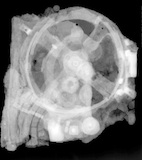
David Ferro’s mission, if he chose to accept it, was to link the Antikythera mechanism, a calculator constructed in about 100 B.C., to the modern computers of today.
Ferro, a longtime Weber State University computer science professor recently named dean of the College of Applied Science & Technology, was up to the challenge, as was his associate and frequent collaborator, student Eric Swedin.
Ferro’s lecture on the topic was part of WSU’s 14th annual Greek Festival, when easygoing professors tend to be assigned offbeat topics like this.
The Antikythera mechanism was a bronze, geared device of intricate design, recovered by sponge divers off the coast of Greece in 1901.
“Gears were not used heavily in that culture,” Ferro said. “It had astronomical signs, and it may have been used to calculate days of the year and solar and lunar eclipses.
“It is considered one of the great treasures of Greece.”
Fragments of the device, lodged in clumps of coral, showed a level of craftsmanship that would not be replicated until 18th-century Europe, Swedin said.
A careful examination of the outside revealed more than a thousand Greek characters. X-rays would reveal multiple gears inside, as well as more than 2,000 additional characters.
The gears had remarkably regular 1.5-millimeter gear teeth, which only could have been crafted by hand.
“Metal objects were very rare,” Swedin said. “The vast majority of people probably worked with metal objects once or twice in their lifetimes.”
The Antikythera mechanism was no doubt made for someone who was rich, Swedin said.
The knowledge embodied in the device might make one wonder why the ancient Greeks didn’t skip ahead directly into their own Industrial Age.
“The answer is, they had slaves,” Swedin said. “There was no incentive to create labor-saving devices, like Europe did when it lost two-thirds of its population to the plague.”
Finding the Antikythera mechanism, Swedin said, “was stone-cold lucky. Most of what is recovered are things passed down for generations or garbage that was thrown away.”
Ferro talked about other early machines, such as the abacus for adding and the astrolabe, an ancient astronomical computer that could be manipulated to solve problems using the position of the sun and stars.
More recent machines included Lord Kelvin’s tide-predicting device built in 1873.
Another, Herman Hollerith’s 1890 tabulating machine, used hole-punched cards that allowed an electrical current to pass, or not, through specific holes, indicating the answers to census questions. Hollerith built the machine after the 1880 census answers took a full decade to tabulate.
The first electrical computers began appearing before World War II. They came from different sources, but all contributed to the early lineage of the computers of today.
So how does the Antikythera tie in to the technical genealogy?
“You may have guessed by now, there is no evidence the Antikythera mechanism had any bearing on computers,” Ferro admitted with a laugh.
Still, Swedin said, the device remains significant.
“To view the world like a machine, where events can be predicted, is one of the greatest intellectual leaps in history,” he said.
“That kind of leap is what led to all of science.”
(source: standard)
See all the latest news from Greece and the world at Greekreporter.com. Contact our newsroom to report an update or send your story, photos and videos. Follow GR on Google News and subscribe here to our daily email!



